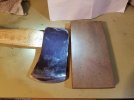David Martin
Moderator
- Joined
- Apr 7, 2008
- Messages
- 19,520
I'm going through my axes and checking them for Fall readiness and noticed my Mann was
not sharp. I remembered using it for limb work back during the Spring. So, I took it to the
coarse side of my fine India and at a 21-22* started working it. It didn't take long, so it wasn't
that dull-- to take a sharp edge. I test it with my thumb nail then run some corners of dirty shop cloths across it. Which it needs to cut these in a 1/2" of movement across the edge.
Removing the burrs on this ax, I'd say is normal, requiring 3-4 flips and a light touch on the
stone. When I achieve this, I call it ready for use and hang it by the shop door. This is sort of
a quick edge but more refined than a file.
I haven't noticed much difference in how long a edge at this grit level last vs taking the edge up to the fine India and working the burrs off. Have you gents? Thanks, DM
not sharp. I remembered using it for limb work back during the Spring. So, I took it to the
coarse side of my fine India and at a 21-22* started working it. It didn't take long, so it wasn't
that dull-- to take a sharp edge. I test it with my thumb nail then run some corners of dirty shop cloths across it. Which it needs to cut these in a 1/2" of movement across the edge.
Removing the burrs on this ax, I'd say is normal, requiring 3-4 flips and a light touch on the
stone. When I achieve this, I call it ready for use and hang it by the shop door. This is sort of
a quick edge but more refined than a file.
I haven't noticed much difference in how long a edge at this grit level last vs taking the edge up to the fine India and working the burrs off. Have you gents? Thanks, DM


